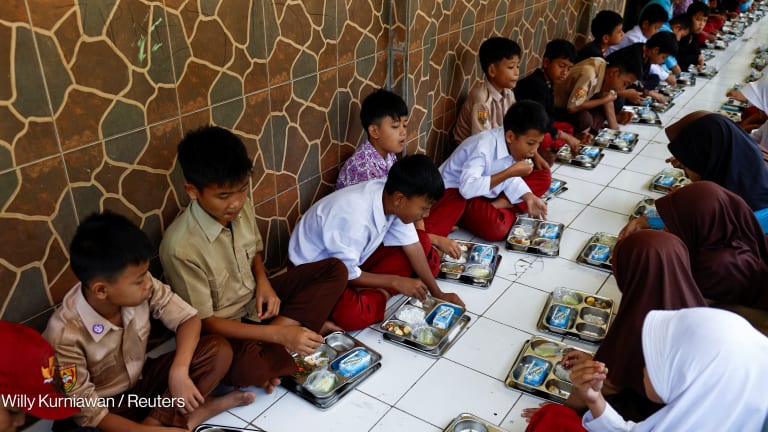
The executive board of the World Food Program has approved a revised school feeding policy that updated the current strategy in place since 2009 and marks a shift in the U.N. agency’s traditional approach to food assistance — from implementer to adviser.
Under its new strategic framework, WFP is now pushing for more sustainable solutions based on county-led programs, linked to local agricultural food systems.
“In general, [we are] moving toward mainstreaming local purchase principles into [our] programs … to more sustainable and more efficient,” WFP policy officer and school feeding specialist Carmen Burbano told Devex. “Certainly the school feeding policy is making a quite strong point [on] where [the agency] is going.”
So what’s new in the revised policy? What does it say about the WFP’s new course? Here are our five takeaways:
1. Transition to country ownership
In the context of the U.N. agency’s broader shift from food aid to food assistance, the approach to school feeding is also changing.
“In the past WFP had implemented school feeding programs … with the support of the governments but not necessarily as part of government or national programmes”, said Burbano, lead author of the organisation’s latest report on the state of school feeding worldwide.
WFP’s intention is in fact to move towards national programs owned by governments. The U.N. agency will engage in policy dialogue and will provide technical assistance, and continue to implement some projects — albeit only fragile nations, until the governments there are able to do it on their own.
2. Context-specific solutions, local purchasing
WFP, explained Burbano, used to have only one, very centralized method of implementing school feeding, but now this will be adapted to the different contexts in each country, fine-tuning programs to be more sustainable, country-specific and cost-efficient.
“For example, in the past [we have] not really incorporated the use of fresh fruits and vegetables in the food baskets because [it was] very difficult to purchase and to transport”, Burbano said, adding that country offices are being instructed to look for locally-produced food that can be more culturally acceptable, more nutritious and have a better impact on local economies.
The changes are not expected to have significant impact on human resources, but they will involve a training scheme for staff on the ground.
3. Sharing knowledge
The most innovative school feeding projects are the ones that manage to integrate the local production into the supply chain, according to Burbano.
For instance, in Ethiopia, the districts buy food from small-holder farmers; in Haiti, WFP is connecting local dairy factories to household that own at least one cow to produce milk, yogurt or cheese for infants; in Cambodia, cash or vouchers distribution to girls instead of food is being tested as incentive to go to school. The goal now is to scale up these initiatives.
“What the policy has done is recognize the innovation within the WFP that is already happening”, said Burbano, adding that “helping our country offices learn from one another” is key, and that’s why the organization is in fact establishing a network and strengthening the mechanisms already in place to for country offices to share their best practices.
4. Increase country funding, cut costs
In 2012, WFP was implementing school feeding programmes in 63 countries, reaching 24.7 million children and spending about $424 million.
“We don’t expect to increase [that investment]”, said Burbano. “[The issue] is to do better what we do with the same amount of money [and] we are increasingly expecting governments to help, to increase their level of participation.”
In line with this, the U.N. agency will pay even closer attention to the cost of all its programs, with measures like requiring country offices to submit annual spending reports, both to improve the efficiency of the programs and increase awareness among the country offices that they have to watch their spending.
5. Strengthening partnerships
How will the new school feeding strategy impact WFP’s implementing partners? To early to say — but they seem to agree with the new direction of the organization.
WFP is strengthening collaboration with partners in key areas such as education, agriculture, knowledge-sharing and research, with key organisations, as well like fellow U.N. agencies like UNICEF and UNESCO or FAO, the World Bank — and emerging donors.
China is feeding around 38 million children every day, they are becoming an increasingly important partner for WFP both providing lessons for other countries in the form of South-South cooperation, but also emerging as a quite important donor. Russia is another country already emerging as school feeding champion. Brazil too, [and] we hope that South Africa and India will come on board”, concluded Burbano.
See more:
Read more development aid news online, and subscribe to The Development Newswire to receive top international development headlines from the world’s leading donors, news sources and opinion leaders — emailed to you FREE every business day.








